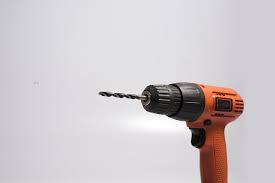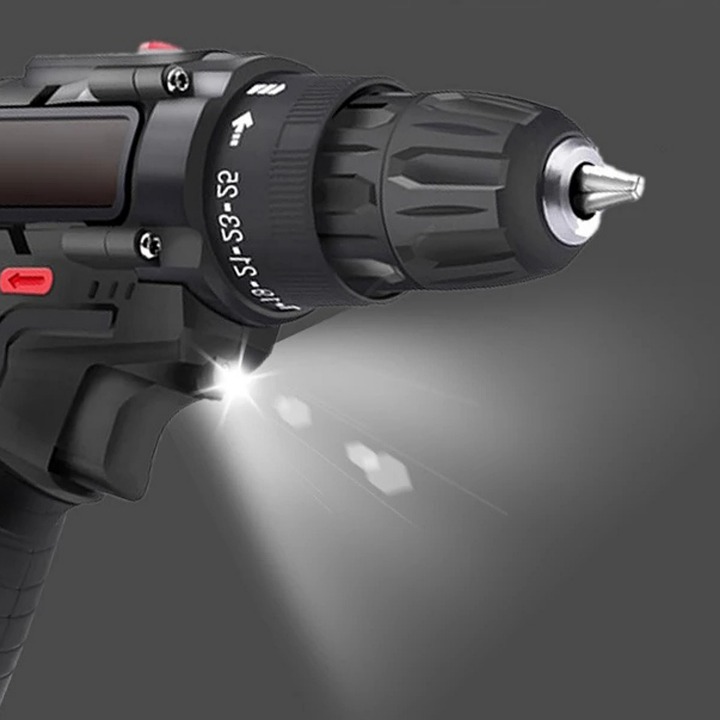Can a Hammer Drill be Used as a Regular Drill?
A hammer drill can be used as a regular type drill. They are a drill/driver, with an added “hammering” function built in. Just like other drills, the hammer drill can drill into wood, plastic, and metal surfaces. It can be used to install fasteners, like screws into any surface you want.
The main difference with a hammer drill is it has an additional hammer feature that can be switched on when needed. This feature allows the user to drill into masonry and brick. Just pop in a masonry bit and start drilling. You will appreciate the ease of use in these surfaces compared to a conventional drill driver.
The Traditional Drill

The traditional drill, also known as a drill/driver is probably the most important tool for any household. Even if you don’t consider yourself very handy, the hand drill is going to find many uses in your home. And for those of us who like to build with our hands, we know the value a good hand drill has.
The drill has two basic functions. First is the ability to drill holes in various materials. Drilling into wood, plastic, and metal are going to be the most common uses for you. You can still drill into masonry but it won’t be easy. Plus, you run the risk of breaking the drill because the motors on them are not built for being used on denser surfaces like masonry.
Their being drivers as well means they are built to drive fasteners into surfaces. This could be driving screws, bolts, or if you use an adapter you can drive a lag bolt. On the drill near the chuck there is a setting that can be adjusted to make the drill stop spinning when needed.
When switched to the driver function you have the option of using different settings. Turn the dial to a number (usually 1-11) and start driving your fastener. If the setting is low the fastener won’t go all the way in. There will be an amount sticking out when the drill stops turning. Just turn to a higher setting and start drilling again.
Once you have the drill set to the right setting you will have no problem driving more fasteners into the material. I like this feature because when it’s set correctly you don’t need to mess with it. When I was working at the cabinet shop this came in handy often. I had a separate drill with the pilot drill bit in it that way I didn’t need to change the setting on my driver.
The Hammer Drill
Hammer drills are like drill drivers in many ways. In fact, they are virtually the same aside from one key feature. They produce a hammering motion on the drill bit that allows holes to be drilled in denser material like masonry and brick. It’s a strong vibrating feeling in your hands that may take some getting used to. When I use these drills for an extended period of time my hands vibrate for a bit after I turn the tool off.
On the dial that has the numbers and the drill setting there is an additional hammer setting. Turning to this option will allow you to engage a hammering motion on the bit. This is designed to drill into harder materials. You aren’t going to use it to drive screws because it may bend or break them.
The drill bits you want to use are different when using the hammering function. Carbide bits can put up with the extra stress from the hammering function. These bits also have a shape that is designed to go into concrete, making them the best option when combined with your hammer drill.
The Impact Driver
Impact drivers are different from drills and hammer drills. When using an impact driver there is a banging sound and vibration coming from it. This is because as it is turning a screw it begins to feel resistance. At this point it starts hitting it very fast to keep turning the screw.
An analogy would be if you are trying to turn a bolt with a wrench and it gets too hard for you to turn. You may take a mallet and begin to hit the end of that wrench to keep it moving. The taps you are making is like what is happening inside the impact driver. There are a lot of taps happening very fast as it is trying to keep the screw turning.
Instead of having a chuck like the drills, the impact driver has a collar with a hexagonal opening. This allows for bits with hexagonal bases to be placed in and locked in place. They won’t slip out when installed correctly.
The hexagonal collar is important because as it’s producing the impacts in a circular motion the bits won’t slip in place. If it was a chuck like a drill the bit would likely slip. One downside to this is the only type of bit that will work for these tools are only ones with a hexagonal base.
There are drill bits available with this base on them. They are more expensive than your conventional round shaft drill bits. You are more limited to only being able to use the more expensive option for drill bits with an impact driver.
Impact drivers are more compact than a hammer drill. The battery balances the motor making it comfortable to hold in your hand. It feels like a light weight dumbbell. This means there is going to be less fatigue when using it for a long period of time. This is good because the shape also makes it easy to use despite all the vibrating it makes.
Impact Driver vs Drill
There are some key similarities and differences between the impact driver and a drill. First let’s talk about the similarities. They are both going to be roughly the same size and weight. The impact driver is a bit more compact than the drill, but not by much.
The speed of an impact driver is faster than that of a drill. This is because the tool offers more torque, and the impact feature of the driver creates less resistance than a drill when used in the same material. If you are wanting to get the job done quickly, then an impact driver is the choice for you.
The biggest difference between an impact driver and a drill is the impact driver takes completely different bits than the drill. I touched on it in more depth above, but what you need to know about this difference is the impact driver cannot take all the bit options the drill has, but the drill can use all the bit options the impact driver has. This is because of the clutch on the drill. The clutch allows for any bit to be inserted. But the collar of the impact driver only allows for hex bases on the bits. These can be slightly more expensive.
Brushed vs Brushless
Brushed and brushless motors are the two most common motor types on the market. Brushed motors are built different from brushless motors. The carbon brushes are on a fixed portion of the motor, and contact the rotating portion. This causes more friction and in turn more heat.
Brushless motors don’t have these brushes. They use a different type of technology to turn the motor. The lack of contact from brushes means they don’t give off as much heat as the brushed motors.
Both types of motors work in the right application. Brushless motors are going to last longer and run cooler than their brushed cousins.
Which Tool Should I Buy?
To answer this question, you will first need to ask yourself what you are using it for? Will you be placing a lot of small delicate screws? Or will you be installing cabinets in your house? This question is important to think about because it will dictate which tool you want to buy.
If you are someone who will be drilling a lot of smaller screws, perhaps some size 6’s to the wall to hang pictures in your house, then you want to get a drill driver. This will allow for the more precise handling needed to get the screw in the right place.
If you are doing larger home repairs and maintenance work my recommendation is to get yourself a hammer drill. This is a versatile all around tool that will be able to do everything you want it to. You may not think you need the hammer function, but when you do it is so nice to have. I don’t use this function often, but it’s a great feature that is a lot of fun to use.
If you like woodworking, then get yourself a hammer drill impact driver combo. This is because you are going to need the versatility of a hammer drill along with the strength of the impact driver. There are some great options on the market that you will be very happy with.

